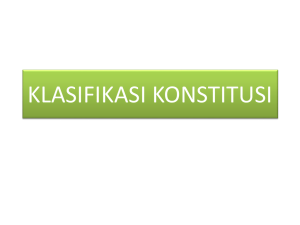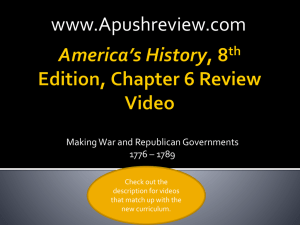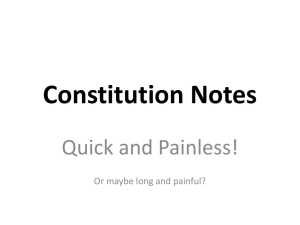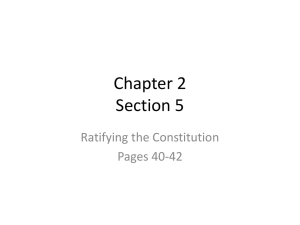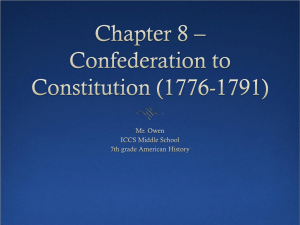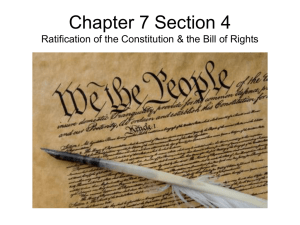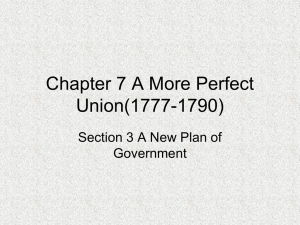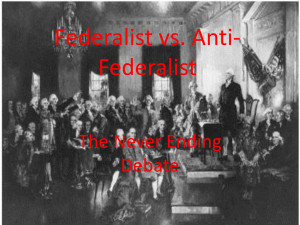File
advertisement
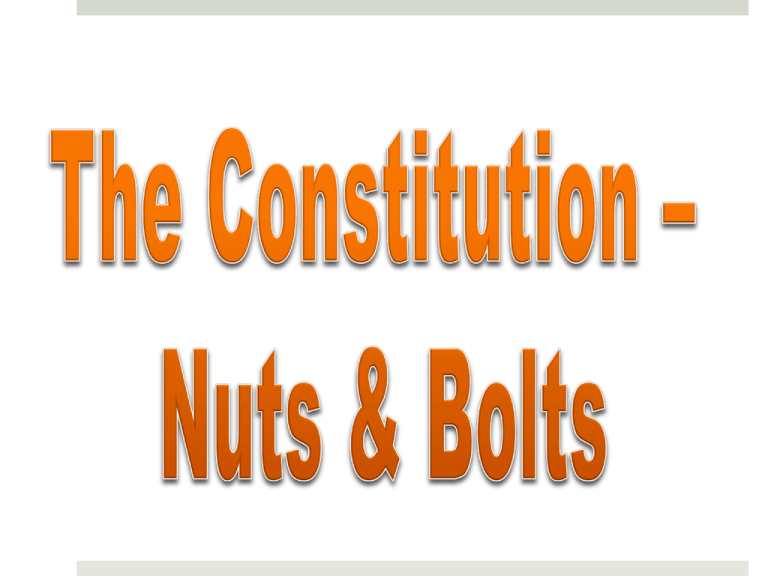
PLAN: • Alliance among 13 states • Each state had one vote in the legislature • Federal government had limited powers PROBLEMS: What problems emerged? • States functioned independently • State representatives were not fairly distributed • The Articles were very hard to amend • Government did not have power to raise taxes or regulate trade •Shay’s Rebellion highlights the issue Shay’s Rebellion MA heavily taxed middle incomes Farmers called for revisions to the state constitution Shays led a march on a federal arsenal Governor sent militia to stop rebellion Illustrated starkly the weaknesses of the Articles of Confederation • Constitution written in 1787 at Independence Hall, Philadelphia, Penn. • The delegates had to solve a number of problems at the Convention Fair Representation in the Legislature Virginia Plan • two house legislature (bi-cameral) • number of representatives based upon population • lower house would elect upper house • checks and balances • supported by large states Fair Representation in the Legislature New Jersey Plan • one house legislature (unicameral) • equal number of representatives from all states • each state would have one vote • the house would appoint executive and courts • supported by small states The Great Compromise Two House Legislature Senate: • state legislature chooses senators (has been modified) • equal representation for each state House of Representatives: • based upon the population of the state • voters choose representatives Counting Southern States • Wanted slaves counted in the population when figuring out the number of representatives each state should have • Did not want slaves counted for taxes the Population Northern States • Did not want slaves to be counted to determine representatives • Wanted slaves counted for taxes The 3/5ths Compromise Compromise counted three-fifths of “other” persons for both representation and taxation Congress also forbidden to interfere with slave trade until 1808 How do you make sure the Federal Government does not have too much power? Constitution • three branches of government •checks & balances limiting three branches powers EXECUTIVE BRANCH (Article 2) The President carries out the laws and can veto a law. He is commander and chief of the military and can be impeached if he breaks the law. Constitution LEGISLATIVE BRANCH (Article 1) The Congress is made up of a twohouse legislature (Senate and House of Representatives). Congress is responsible for making the laws. JUDICIAL BRANCH (Article 3) The Supreme Court and other federal courts interpret the law of the land and decide if it is constitutional. • 9 out of 13 states had to ratify (approve) the Constitution • Debate ensued between the Federalists and Anti-Federalist • The Federalist side was outlined in the Federalist Papers Convincing 9 states to ratify the Constitution Who should have the power? • form of government where power is divided between a national government and state governments 1. In a federal government who should have more power – the national or state government? Why would this concern citizens? 2. What about individual powers? How do the rights of individuals fit into the division of powers? Why would this concern citizens? What types of government did the Federalists and AntiFederalists prefer? Anti-Federalists wanted more representation. They worried that 1 person could not adequately represent 30,000 people. Federalists disagreed. After the Constitution was written, it had to be ratified by 9 states…extensive debates between Federalists (supported the Constitution) and Anti-Federalists (opposed a strong central government). Federalists vs. Anti-Federalists Read document written by Alexander Hamilton (remind me to give you my cheat sheet…I always forget!) Read document by Melancton Smith Fill in the graphic organizer Federalists vs. Anti-Federalists What was Hamilton’s position on representation? What was Smith’s position? What arguments did they make in support of their claims? Based on these arguments, what type of people would you guess tended to be Federalists? Anti-Federalists? PROMPT: If you could have chosen, what side would you have supported? Do you see versions of these issues being debated today? (Look something up!) FEDERALISTS In favor of ratification Property owners, landed rich, merchants Believed in elitism. Saw themselves and those of their class as most “Fit” to govern. Support concentrated in coastal areas and large cities Powerful central government . 2-house legislature. Representative democracy, with single reps for 30,000 people Leaders included Hamilton and Madison (Known as “Publius”) ANTI-FEDERALISTS Opposed ratification Middle-class, small farmers, shopkeepers, laborers & favored civil liberties (ind. Rights) over strong govt Believed in decency of the common man & participatory democracy Viewed elites as corrupt. Included Patrick Henry, George Clinton, Mercy Otis Warren Thomas Jefferson, “Brutus” and “Cato” What actually happened? New York ratified the Constitution by a vote of 30-27 (the narrowest margin of victory of any state that met in 1787-88) The Anti-Federalists lost the battle but won the war. The first 10 amendments to the Constitution – the Bill of Rights – were ratified in 1791. These addressed many of the issues that the Anti-Federalists raised in the conventions. To address these questions our Constitution: A. Authorizes the Congress to make laws only in areas granted to it. B. Some lawmaking authority was left to the states. C. A Bill of Rights was added to the Constitution to guarantee that the laws passed by the states and Congress do not violate Civil Rights Even with distribution of power being included within the Constitution, conflict still arises between states, national government, and individual rights. Example #1: Medical Marijuana Example #2: Gay Marriage • Electoral College each state is assigned a number of electors (number of senators and representatives combined) political parties in each state choose who will serve as an elector citizens vote for their president (called the popular vote) the popular vote is supposed to dictate the electors votes – but four times in history the candidate with the largest popular vote has lost the election • Amending the Constitution there are two ways to amend the Constitution – only one way has ever been used a bill can be proposed to amend the Constitution, it must be passed by a 2/3 vote in both the Senate and House of Representatives then the bill is sent to all the state legislatures 3/4 of the states must approve the bill for the Constitution to be amended there are currently 27 amendments – the first ten are “The Bill of Rights” • Impeachment House of Rep. must determine if there is evidence that a crime has been committed, if so, they submit articles of impeachment to the Senate The Senate oversees the trial of the accused government official Andrew Johnson 2/3 of Senate must vote guilty in order for him/her to be removed from office If found guilty, may NEVER hold public office Crimes considered “impeachable” – treason, bribery, other high crimes and misdemeanors Bill Clinton

